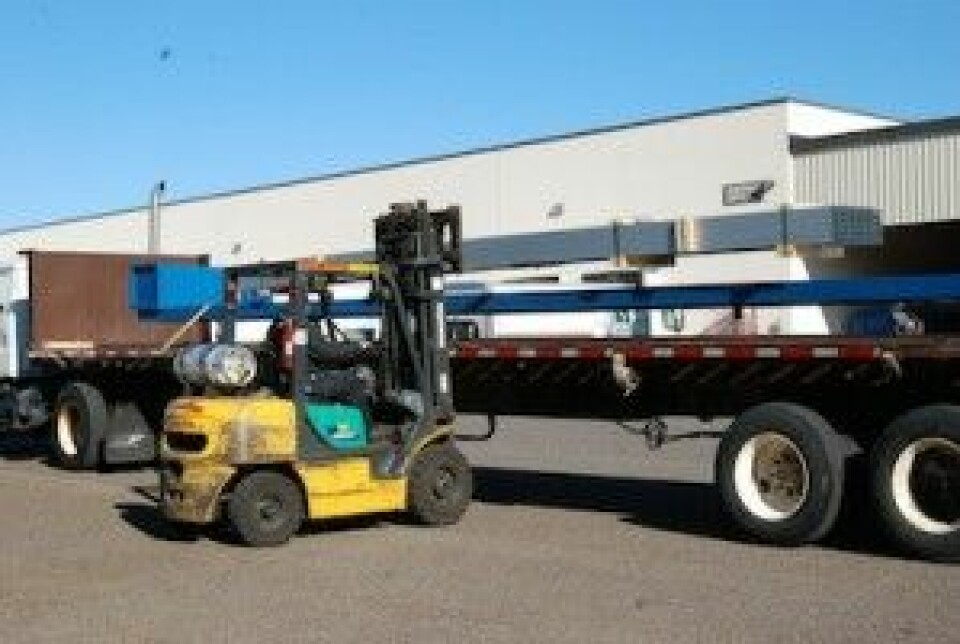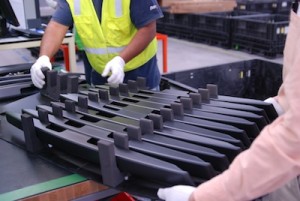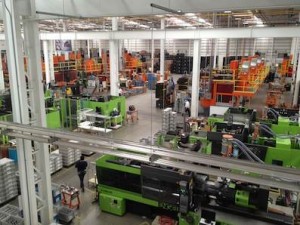Feeding the lean machine in North America
Efficient and growing production is putting pressure on tier suppliers to better manage their own logistics networks in North America
Tier one suppliers in North America are facing both global and regional supply chain challenges. As vehicle production grows across the continent, particularly in the southern states of the US and Mexico, suppliers are revaluating their own production and logistics flows to accommodate increased demand within wider and more complex networks. Many tier one suppliers have extended their reach beyond North America to serve the expansion of global production platforms and modular strategies among carmakers. To manage this growing complexity, some tier ones are relying more on advanced IT systems to increase their supply and network visibility, as well as the expertise of third party logistics providers.
Higher demand has meant that production capacity has generally been tighter in recent years throughout the North American supply chain, according to Dave Andrea, the Original Equipment Suppliers Association’s (OESA) senior vice-president of industry analysis and economics. Andrea says that although capacity shortages are not systemic, they exist in pockets among some commodities and processes. The result, he says, has been more pressure on managing a tier supplier’s inbound and outbound logistics. “Since the industry is running lean, with lower inventory, it increases pressure on logistics for just-in-time (JIT) deliveries,” he says.
“We need logistics improvements across the board for two primary reasons,” he adds. “One is that new production programme launches add volatility to the supply chain and the other is to handle incremental volume increases.”
Jim Barnett, vice-president of the automotive sector for the Americas at Ceva Logistics, points out that, particularly since the financial crisis, OEMs and tier one suppliers have reduced their breakeven point for production in North America, but assembly and output has since recovered to reach record levels, despite only a few new plants being added. A good number of plants and OEMs have switched to three-shift production, for example, and there have been some constraints in supply and logistics.
“Everyone wants to get the maximum production without the need to add bricks and mortar or permanent staffing,” he says. “This has resulted in a rationalised footprint for the automotive industry in North America that is massively more efficient than it was five years ago. But at the same time, as volume increases are required, this has resulted in capacity constraints.”
As production grows, carmakers and tier suppliers are once again investing in factories, however. Andrea points out that the greatest amount of new capacity will emerge in central Mexico, where by 2017, about a quarter of all North American vehicle production will be located. “Two-thirds of the suppliers that we surveyed plan to add incremental capacity in Mexico,” he says.
Barnett adds that tier one suppliers are also moving southward so as to better match their production footprints to the development of new transplant OEMs in Mexico and the American southeast; many are also doing so to take advantage of lower labour costs.
"The automotive industry in north America is massively more efficient than five years ago, but as volume increases are required, this has resulted in capacity constraints" - Jim Barnett, Ceva Logistics
Despite these shifts, it should be noted that production has risen strongly among Detroit-based manufacturers in plants from the Midwest to Texas. According to Barnett, there is a need for creative solutions to support tier one suppliers that are working three shifts and maximising production. Perhaps more than ever before, suppliers need more pan-North American strategies, which extend beyond one part of the country and include both localisation in certain regions, as well as cross shipping between locations.
Shape shifting in North America
Shape Corporation is among the tier one suppliers that is increasingly developing such a broad logistics strategy. A manufacturer of bumper beams and related products based in Grand Haven, Michigan, Shape has seven plants in the state. It has also begun pre-production, including the final weld and application of E-Kote, a black rustproof paint, at a plant in Texas that serves General Motors’ Arlington plant, which it currently ships to from Michigan. “We will begin operations at the end of December when GM introduces its new model,” says Kevin Wickering, logistics manager of purchasing.

Shape also has a plant in Mexico, in the north-central state of Queretaro, which mostly supplies car production in Mexico. For this plant, Shape’s transport modes include truckload, less than truckload, intermodal, 18.3-metre boxcars and flatbed trucks. A majority of flows in Mexico move by intermodal and boxcar rail. Wickering notes that four semi-trailer loads fit in one boxcar, which makes the mode quite efficient by weight despite its longer lead times.
Within the US, Shape ships by intermodal and boxcar methods, except to GM’s Arlington plant, where it uses trucks, flatbeds and intermodal transport. Movements from the US to Mexico also include intermodal flows.
“A 60ft boxcar takes 18-19 days to reach Mexico, while intermodal takes ten days and truck takes six days,” he says. “We balance the need for JIT deliveries with the cost per pound.”
The use of transport mode depends on the volume of a product and the distance it will move, says Wickering. He says a trend toward aluminium bumpers has led Shape to combine more steel with aluminium or plastic to get the most density out of both the weight and volume of its loads.
Total cost considerations at Draexlmaier
Another tier one supplier that has an increasingly integrated North American logistics strategy is Draexlmaier Automotive of America, a German supplier with two divisions in North America. For its electrical segment, Draexlmaier has one plant in Nicaragua and four in Mexico. A distribution centre located in Duncan, South Carolina, serves BMW’s Spartanburg plant. The firm’s interior section has a plant in San Luis Potosi in central Mexico and one in Duncan, while it also shares the distribution centre in Duncan with its electrical segment. In San Luis Potosi and in Duncan, Draexlmaier maintains two off-site inbound warehouses, which manage the delivery of material into the production cells.
Heiko Laessig, senior manager for logistics, says Draexlmaier’s Interior Segment has made a significant effort to localise its supplier base, with about 90% of its suppliers local in North America for both segments. The remaining 10% of material comes from Europe and Asia. On the electrical side of the business, Draexlmaier still receives 60-70% of its raw materials from Europe.
Laessig says Draexlmaier works carefully to evaluate the total cost of the network by taking space and investment restrictions into consideration. The supply chain must balance these factors as well as the need for fast-moving flows. “In our strategic planning process, we make sure that long lead time elements such as infrastructure, big machines, etc. are available,” he says. “For short-term changes, we have created some mechanisms to flex our capacity. For example, our inbound warehouses are off-site and we also negotiate a set price with our logistics service providers.”
Flexibility in response to capacity crunches
The production growth in North America has tested both Shape and Draexlmaier’s logistics networks. Wickering says that Shape has seen capacity issues spike in the last six months of 2013 and the company’s expectations are that the situation will worsen in 2014. The supplier has looked to a number of ways to help buffer these capacity issues, including outsourced warehouse and off-site locations.
“Our current challenge is to maintain sufficient manufacturing space,” says Wickering. “We need space for inventory control, work-in-progress material between plants, finished goods material and empty returnable containers,” he says. “Thus, we have opened warehouses where we lease space to manage our finished goods inventory and containers.”

Shape also uses warehousing in which its logistics providers do the material handling, which frees up space at its own plants and warehouses. “At these facilities, we have invested in scanning devices and wireless capacity for our own terminal. This makes sense since manufacturing space is much more expensive than warehousing space,” he adds.
As production demand increases, Draexlmaier is watching developments in the trucking industry and the growing business in Mexico carefully. “The rising average age of truck drivers is a big concern to us. This is likely to lead to an increase in truck prices,” says Laessig. “In order to deal with this, we have developed strategic relationships for key lanes with asset-based carriers.”
Mexico, as mentioned, is among the locations where production has grown most, and where supply and logistics capacity is expected to be the most strained. Laessig points out that Mexico is attracting more and more industries and companies, while the logistical infrastructure is not growing at the same proportion, resulting in longer times for border crossings. As a result, Draexlmaier is developing alternative modes and is using less congested routes to cross the border.
The company has also developed innovative packaging designs that have reduced its expenses substantially, he says. “In particular, packaging for interior leather products is very sensitive. Yet, a higher pack density reduces transportation costs and handling costs. We have saved between $12m-$15m.”
Barnett says that customers are consistently asking Ceva Logistics to be more flexible in its operations because of both complexity and capacity issues in the supply chain. “Because of their length and complexity, supply chains are much more fragile today than they have been in the past,” he says. “As we have seen in recent years, natural disasters can have a huge impact on suppliers’ and OEMs’ supply chain and bottom line performance, and we need to respond better.”
Localising with global production platforms
Another factor influencing tier suppliers’ logistics networks in North America is the expansion of global production platforms. Wickering points out that General Motors uses shared platforms with different variations for North America, Europe, and lower cost countries. Some components are unique to each region, while some are common to all, depending on evaluations of what GM calls ‘total enterprise cost’, including logistics, capital, tooling, labour, duties, tariffs, taxes and trade agreements, as well as supply chain risk. Shape is also using such considerations in its production and sourcing decisions.
“In the past, we produced it all here [North America] and exported it,” says Wickering. “Now, we must have a local presence [in global markets]. In the past year, we have added [facilities or suppliers] that are more localised to the customers in order to do the finished work.”
Wickering says that in China, Shape is a supplier of the last component. It serves a Toyota plant that is located about 12 hours from Shape’s production facility. “Although our steel bumper beams pack densely and weight out, the bracket attached to the beams causes us to lose pack density,” he explains. “Therefore, if the logistics costs become high or the distance is long, we want a manufacturing partner to provide stamping or E-Kote that is closer to the customer.”

Not every tier supplier has seen global platforms alter its logistics strategies, however. Laessig says that Draexlmaier provides a significant amount of sequenced content. Since most of its parts are individual to each car line, he does not see a big change. “However, for some parts, our customers direct us to choose certain non-localised suppliers, which is in line with the OEM’s global platform strategy. These include doors and centre consoles, which differ per car line,” he says.
Barnett adds that Ceva has seen many operations move from a domestic focus towards supporting programmes for exporting and importing vehicles and parts that make up a global platform. “More of our customers are asking us for a complete supply chain solution,” he says. Ceva has responded to these demands with solutions such as the Ceva Matrix platform, which allows global visibility of inventory levels and a granular level of events from a customer’s order to the delivery of goods at the door.
IT developments
In some cases, global platforms have led to greater demand either for sophisticated IT systems or for 3PLs with stronger IT specialisation. For example, Shape exports 10% of its products overseas, material which the company is looking for a 3PL to provide more visibility over ocean exports, according to Wickering. “Here, IT capacity is a bigger part of the equation. With a transit time of three to five weeks, the ability to provide visibility distinguishes 3PLs,” he states.
Shape began working with global 3PL Seko Logistics this year. “We can use Seko’s web-based system as our own for shipment documentation and customs clearance. It offers a lot of flexibility and interactive capabilities,” says Wickering.
Another of Shape’s challenges has been the need for new yard management technology. Wickering says that its extra warehouses created a lot more in-transit product between its plants and warehouses as well as more inter-plant shuttles. On average, Shape has 70 trailers moving between seven or eight plants, using 125 docks. Shape’s use of YardView yard management software enables the driver and dispatcher to see which trailer is in which dock. The driver uses an electronic tablet to record their shipment as delivered and then receives instructions to their next stop. “This will save us money by requiring fewer trucks and drivers,” explains Wickering.
At Draexlmaier, Laessig says all of its facilities operate within the same IT landscape, which links inventory and production to the tier supplier’s trucking providers. In general, Draexlmaier develops in-house all of its systems that interface with customers; Laessig says this approach helps to guarantee adaptability to customers’ needs. However, he sees scope for the company to develop or purchase more advanced systems or transport routing and optimisation.
A merging logistics landscape
Another factor influencing logistics network design is the continuation of mergers and acquisitions among tier suppliers, a process that accelerated during the economic downturn and has continued in many areas. As a result of these mergers, a number of the leading tier one suppliers have gravitated toward decentralised purchasing and logistics systems.
"The rising average age of truck drivers is a big concern to us. This is likely to lead to an increase in truck prices [so] we have developed strategic relationships for key lanes with asset-based carriers" - Heiko Laessig, Draexlmaier
“The trend, however, is toward more centralisation for direct materials as well as indirect purchases,” says Andrea. “It is about balancing local expertise and flexibility to scale and efficiency driven by centralisation.”
There are advantages to decentralised logistics networks as well. At Seko Logistics, Rich Grant, director of strategic clients for the east coast region, warns that a centralised logistics network can risk losing local and historical intelligence. Decentralised approaches, which give more flexibility and control to individual plants or divisions within a supplier, tend to focus more on performance and are often able to react fast to problems or changes in manufacturing and supply.
Grant also observes that there have recently been more mergers and acquisitions among tier two and three suppliers than among tier ones. He has also observed changes in the high-tech sector, which has seen more partnerships among companies as well as more localisation. “We are seeing more joint ventures between technology providers and tier one suppliers, including branding with Microsoft and Sysco. There has been more near-sourcing in high-tech to get closer to the customers,” he says.

Barnett says that merger and acquisition activity has had some major impacts for Ceva Logistics, mainly as a result of its customers’ merger strategies. He notes that the supply chain department is often responsible for delivering some of the expected cost savings through synergies in operations. Ceva’s first task is to help that group achieve savings as soon as possible, he says. Some areas where that might need to happen include combining existing logistics networks to gain synergies and expand the services and systems scope to include better visibility and control. Barnett says that this involves unifying customer processes and touch points across operating divisions. It also entails re-pricing the entire network to take advantage of increased volumes.
Mergers and consolidations, together with shifting geographies and global demand, continue to influence North American tier suppliers. As the continent sees both growth and new supply flows, there is little question that such complexity for the suppliers’ supply chain will also continue to change their logistics, sometimes dramatically.






